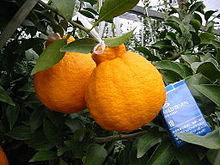Dekopon
| Dekopon | |
|---|---|

Dekopon on tree
|
|
| Hybrid parentage | Kiyomi * ponkan (Nakano no.3), |
| Origin | developed in Japan in 1972 |
Dekopon (デコポン?) is a seedless and sweet variety of mandarin orange.
It is a hybrid between Kiyomi and ponkan (Nakano no.3), developed in Japan in 1972.
Originally a brand name, 'Dekopon' has become a genericized trademark and it is used to refer to all brands of the fruit; the generic name is shiranuhi or shiranui (不知火?). Dekopon is distinctive due to its sweet taste, large size and the large protruding bump on the top of the fruit.
The name is most likely a portmanteau between the word deko (凸, デコ; meaning convex) as a reference to its bump, and the pon in ponkan (ポンカン; one of the fruits that it is derived from) to create 'dekopon' (デコポン).
There were many market names for 'dekopon' during the time 'dekopon' was a trademark of the product from Kumamoto. For instance, himepon was the market name for the fruits originating from Ehime prefecture. The ones grown in Hiroshima prefecture were marketed as hiropon. However, after an agreement whereby anyone can use the name 'dekopon' if they pay a fee and meet certain quality standards, the name "dekopon" is used for products from anywhere in Japan.
'Dekopon' does not have an agricultural variety registration number (Nōrin Bangō) because of its bump, which at the time of its development was considered to be unsightly, and failure to reduce acidity in the fruit.
The fruits are usually grown in large greenhouses to keep them at a constant temperature, and are harvested from December to February (winter in Japan), while in the case of garden farming, they are harvested from March to April. After harvesting, dekopon are usually left for a period of 20–40 days so that the levels of citric acid in the fruit lower while the sugar levels increase, to make a more appealing taste for the market. Only products with sugar level above 13°Bx and citric acid below 1.0% can be sold with the name dekopon.
...
Wikipedia
